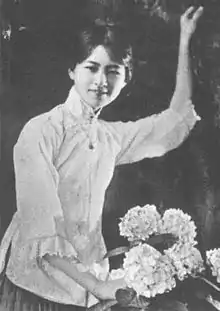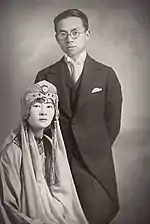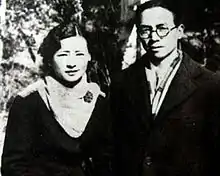Lin Huiyin
Lin Huiyin (Chinese: 林徽因, born 林徽音; pinyin: Lín Huīyīn; known as Phyllis Lin or Lin Whei-yin when in the United States; 10 June 1904 – 1 April 1955) was a Chinese architect and architectural historian. She is known to be the first female architect in modern China and her husband the famed "Father of Modern Chinese Architecture" Liang Sicheng,[1] both of whom worked as founders and faculty in the newly formed Architecture Department of Northeastern University in 1928 and, after 1949, as professors in Tsinghua University in Beijing. Liang and Lin began restoration work on cultural heritage sites of China in the post-imperial Republican Era of China; a passion which she would pursue to the end of her life. The American artist Maya Lin is her niece.[2]
Phyllis Lin | |
|---|---|
 | |
| Born | 10 June 1904 |
| Died | 1 April 1955 (aged 50) |
| Resting place | Babaoshan Revolutionary Cemetery |
| Alma mater | University of Pennsylvania |
| Occupation | architect, poet |
| Spouse(s) | Liang Sicheng, m. 21 March 1928, wid. 1 April 1955 |
| Children | Liang Congjie Liang Zaibing |
| Relatives | Liang Qichao (father-in-law) |
Biography


Lin was born in Hangzhou though her family was from Minhou. She was the daughter of Lin Changmin (林長民) (16 September 1876 - Minhou, 24 December 1925) and He Xueyuan (何雪媛) (1882–1972).
In a time when women had limited access to formal education, Lin was able to receive a formal education due to being part of a wealthy family. Because of her family's affluence she was able to travel extensively with her father. She obtained her degrees both in England and the United States. Lin first studied in London where she attended St Mary's College. In the early 1920s, Lin Huiyin's modern conceptions were unique and romantic compared with other writers. [3]It was there she became acquainted with the well known Chinese poet Xu Zhimo. Their relationship was a sensational part of Lin Huiyin's life and is referred to in romantic anecdotes. However, Lin's works are highly regarded. Lin wrote free verse, novels and prose. Lin's poems appeared in publications such as the Beijing Morning Post, Crescent Monthly, Poetry and the Dipper and the newspaper L'impartiale in Tianjin.
In 1924, Lin and Liang Sicheng both enrolled at the University of Pennsylvania, where she also worked as a part-time assistant in the architectural department. Although they both wanted to attend the School of Architecture, Lin was not admitted because she was a woman. She therefore enrolled in the School of Fine Arts.[4] Later, she enrolled in stage design programs in Yale University as a graduate student, pursuing her longtime interest in drama.[2]
During her studies she pursued her passion for architecture by taking architectural classes.[5][6] It was here that Lin along with Liang Sicheng, her future husband whom she had known since childhood, pursued their love of architecture.
In April 1924, the sixty-four-year old Indian poet Tagore visited China, Lin Huiyin and Xu Zhimo worked together to do the interpretation work for Tagore, during which Lin Huiyin distinguished herself with her fluent English and also won the admiration of the poet.[7]
Career
In the wake of the September 18th Incident, Lin left for Beijing, where she studied ancient Chinese architecture. Upon her return, she helped to establish the Architectural Department at Northeastern University in Shenyang, where she then taught architecture briefly.[8] Meanwhile, in 1928, she designed a railway station in Jilin. This was one of the few buildings Lin designed. Throughout the 1930s, Lin and her husband lived in Beiping, as Beijing was then called, near both of their families. Close friends at the time were the Americans Wilma and John K. Fairbank, who admired her sense of living on a “kind of double cultural frontier,” and facing the problem of “the necessity to winnow the past and discriminate among things foreign, what to preserve and what to borrow.”
In 1936, in order to develop measurement records of the Chinese ancient architecture, Lin Huiyin and her husband climbed the roof of the Temple of Heaven; she became the first woman to attempt the walk on the emperor's palace roof. In 1937, she discovered the main hall of Foguang Temple near Doucun, Shanxi. The hall was the only remaining Tang dynasty timber structure known at the time.[9]

As Japan's invasion loomed, Lin Huiyin and her husband had to cut-short their promising restoration work of Beijing's cultural heritage sites in 1937 and abandoned their now famous courtyard residence in Beijing[11] to flee southward along with personnel and materials of the Architectural Department of Northeastern University; their exodus lead them and their children to temporary settlements in the cities of Tianjin, Kunming, and finally Lizhuang in 1940.[12] It was in Lizhuang where the bedridden Lin Huiyin, suffering from tuberculosis, was told of her younger brother's martyrdom while serving as a combat aviator in the air force in the defense of Sichuan (fmr. sp.: Szechuan:).[13] Lin wrote a poetic memorial commemorating her brother (opening excerpt):
Brother, I do not have words appropriate for this era to mourn over your death. This era made a simple request of you and you responded. Your absolute and simple heroism is a poem of this era. I want to add more sorrow to the unavoidable reality by screaming - you understand why - that you have gone too soon. Brother, your bravery is great. Your death is too cruel.
After 1949, Lin Huiyin became a professor of architecture at Tsinghua University. As a literary writer and architectural historian, Lin Huiyin rebuilt the capital from the aspects of cultural tradition, architectural beauty, historical significance, and living conditions of the people. Meanwhile, Lin Huiyin participated in the design of the "National emblem" and the "Monument to The People's Heroes".[15] Lin designed the floral wreath patterns at the base of the Monument to the People's Heroes. Lin also took part in the standardization of Beijing city planning.
She died in 1955 of tuberculosis.[16]
Publications
Lin Huiyin wrote poems, essays, short stories and plays. Many of her works were praised for their subtlety, beauty, and creativity. Some of her more well known works are: Smile, Ninety-nine Degrees, Don't Let Our Land be Lost Again! and Meizhen and Them. Lin along with her husband wrote a book titled A Pictorial History of Chinese Architecture.[17] During this pursuit, Lin along with her husband went to thousands of ancient Chinese architectural sites. She conducted research and preserve China's architectural history. They lobbied hard to protect many of the old buildings in Beijing at a time when many parts of the city were being leveled by the municipal government.[18] She also translated English works into Chinese.
Literature
Lin Huiyin is well known for her many poems and essays, she was also one of the outstanding female representatives of the May Fourth Movement. Her essays are full of delicate feelings and are combined with the musical sense in the Chinese poetic tradition. Her novels are full of modern content, such as the most famous "You Are the April of This World". Similarly, Lin Huiyin and other writers also participated in the May Fourth Movement. Unfortunately, "gender" has a great irony for the national cultural revival of the May Fourth Movement. Under the hegemony of antitraditionalism, it made the environment for female writers tougher. Nevertheless, Lin Huiyin skillfully integrated the aesthetics of Tang poetry into the language and syntax of modernism and used the traditional literary practice of episodic narration to combat the gender determinants of these idioms. Lin Huiyin was fond of free love and ideal, but the free love under May Fourth turned into the tragic idealism in the social background, which exacerbated the pain of gender oppression.[3]

In addition to architectural research, Lin Huiyin also engaged in literary creation. As a young girl, Lin Huiyin went abroad with her father to study in Europe. In England, Lin met Xu Zhimo in England, who guided her to the road of literature. Therefore, Lin Huiyin set her foot on the road of literature. Xu Zhimo encouraged Lin Huiyin to write literature, especially poetry. Later, they organized activities, performed dramas, and experimented with more literary forms together.[19] When Rabindranath Tagore came to China, Lin and Xu worked together as translators, contacting the great poets of the world and learning poems from Tagore.[20] She was more famous because she became the leading lady in Tagore's drama "Chitra".[21]
Lin Huiyin has a strong understanding of literature, therefore, her poems are rich in themes. During the transient years, in the quiet contemplation at night, Lin Huiyin has been used to expressing her feelings in poetry. Her poems often reveal the subtlety of human love, the silent beauty of nature, and the fortitude of life.[22]
Legacy

In October, 2010, as part of a revival of Lin Huiyin and her husband's life accomplishments, CCTV broadcast a six-hour, eight-episode documentary on the husband and wife.[12] The documentary is titled Liang Sicheng Lin Huiyin and was directed by Hu Jingcao. Although Lin did not receive the recognition due to her during her lifetime because she was a woman, there is now a renewed revival of her legacy. It has been quoted of Lin Huiyin that "it is often only through the light given off by a man that we see the woman behind him, particularly so for young women in the arts who emerged from the republican era. But Lin Huiyin is an exception. In her, we see the reflection of many outstanding men of the time, but in fact it is she who adds extra color and shine to their images."[23]
In 2018, the New York Times wrote a belated obituary for Lin Huiyin and her husband.[24]
 Young Lin Huiyin
Young Lin Huiyin Lin Huiyin and Liang Sicheng
Lin Huiyin and Liang Sicheng Lin Huiyin, Rabindranath Tagore and Xu Zhimo
Lin Huiyin, Rabindranath Tagore and Xu Zhimo Liang Sicheng, Lin Huiyin, Zhou Peiyuan and others
Liang Sicheng, Lin Huiyin, Zhou Peiyuan and others Lin Huiyin with her father Lin Changmin (zh:林長民)
Lin Huiyin with her father Lin Changmin (zh:林長民) The jade disc design of the National Emblem of the People's Republic of China proposed by Lin Huiyin
The jade disc design of the National Emblem of the People's Republic of China proposed by Lin Huiyin
Notes
- ARTINFO (6 February 2012). "Shady Beijing Developers Demolish the Home of China's "Father of Modern Architecture"".
- Peter G. Rowe, Seng Kuan, Architectural Encounters With Essence and Form in Modern China, MIT Press, 2002, p.219, ISBN 0-262-68151-X
- SONG, Weijie (2014). "The Aesthetic versus the Political: Lin Huiyin and Modern Beijing". Chinese Literature: Essays, Articles, Reviews (CLEAR). 36: 61–94. ISSN 0161-9705. JSTOR 43490200.
- Slotnik, Daniel E. (11 April 2018). "Overlooked No More: Lin Huiyin and Liang Sicheng, Chroniclers of Chinese Architecture". The New York Times. Retrieved 16 April 2018.
- Ideology and Culture in China; http://en.gmw.cn/2013-12/12/content_9786921_2.htm#Content_Title
- Donald Langmead (2011). Maya Lin: A Biography. Greenwood Biographies (illustrated ed.). ABC-CLIO. p. 19. ISBN 978-0313378539. Retrieved May 17, 2014.
- "一代才女林徽因:三个爱情故事的女主角_中国网". www.china.com.cn.
- Wiki China; http://wiki.china.org.cn/wiki/index.php/Lin_Huiyin
- John King Fairbank. Chinabound: A Fifty-Year Memoir. New York: Harper & Row, 1982. ISBN 0060390050, p. 106-108.
- https://air.mnd.gov.tw/EN/PastCurrent/PastCurrent_Detail.aspx?FID=28&CID=175&ID=1278
- http://en.bjchp.org/?page_id=2676
- "Liang Sicheng and Lin Huiyin, CNTV English, CCTV News". cctv.cntv.cn.
- "Journeys in Time 2011-05-24 Liang Sicheng and Lin Huiyin Part 8 CCTV News - CNTV English". english.cntv.cn.
- "五大隊第十七中隊 林恒". www.flyingtiger-cacw.com.
- Kalman, Harold (2018). "'Chinese Spirit in Modern Strength': Liang Sicheng, Lin Huiyin, and Early Modernist Architecture in China". Journal of the Royal Asiatic Society Hong Kong Branch. 58: 154–188. ISSN 1991-7295. JSTOR 26531708.
- Andrew Jacobs, In Beijing’s Building Frenzy, Even an ‘Immovable Cultural Relic’ Is Not Safe, New York Times, New York edition, February 5, 2012, page A6
- Amy D. Dooling, Kristina M. Torgeson, Writing Women in Modern China: An Anthology of Women's Literature from the Early Twentieth Century, Columbia University Press, 1998, p.301, ISBN 0-231-10701-3
- "Lin Huiyin: 'Lady of Letters'". china.org.cn.
- Song, Weijie (2018). Mapping Modern Beijing: Space, Emotion, Literary Topography. Oxford University Press. ISBN 978-0-19-020067-1.
- Shih, Shu-Mei (2001). The Lure of the Modern : Writing Modernism in Semicolonial China, 1917-1937. University of California Press. p. 207. ISBN 9780520935280.
- Lee, Lily Xiao Hong; Stefanowska, A. D.; Wiles, Sue (1998). Biographical Dictionary of Chinese Women. M.E. Sharpe. ISBN 978-0-7656-0798-0.
- Carles, Prado-Fonts (2010). Fragmented Encounters, Social Slippages: Lin Huiyin's "In Ninety-Nine Degree Heat.". pp. 125–141.
- The China Beat; http://www.thechinabeat.org/?p=2958
- "Overlooked No More: Lin Huiyin and Liang Sicheng, Chroniclers of Chinese Architecture". 11 April 2018 – via NYTimes.com.
Further reading
| Wikimedia Commons has media related to Lin Huiyin. |
- Fairbank, Wilma. Liang and Lin: Partners in Exploring China's Architectural Past. University of Pennsylvania Press. 1994. ISBN 0-8122-3278-X
- Ch 9, “Chinese Friends,” John King Fairbank. Chinabound: A Fifty-Year Memoir. New York: Harper & Row, 1982. ISBN 0060390050), pp. 104–113.
- Sicheng Liang, translated by Wilma Fairbank. A Pictorial History of Chinese Architecture: A Study of the Development of Its Structural System and the Evolution of Its Types. (Cambridge, MA: MIT Press, 1984). ISBN 0262121034 Reprinted: Dover: 2005.
- Wong, Sidney (黄振翔). "Lin Huiyin (林徽因) and Liang Sicheng (梁思成) as Architectural Students at the University of Pennsylvania (1924-27)" Planning and Development Volume 23, No. 1, page 75–93, 2008.